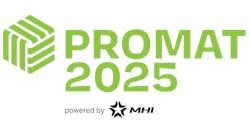At first glance, leading off North America’s largest material handling and logistics show—ProMat 2019, held this week in Chciago—with a keynote session on blockchain might seem a curious choice. After all, the technology is hardly battle-proven for supply chain applications; some might say it’s hardly battle-proven for any applications. According to the 2019 Annual Industry Report from MHI and Deloitte, blockchain has the lowest adoption rate (10%) of any of the disruptive technologies mentioned in the report, which was based on a survey of more than 1,000 supply chain professionals. And of those companies who do intend to invest in blockchain and distributed ledger solutions, nearly half will spend less than $1 million. So not exactly a ringing endorsement of the technology, at least not in a 2019-2020 timeframe.
Taking the healthy amount of skepticism surrounding the technology as his cue, Karim Lakhani, a professor of business administration at Harvard Business School, acknowledged that the hype over blockchain has been unfortunate, in that it has clouded its very real potential.
“Blockchain is a foundational, not a disruptive, technology,” Lakhani pointed out. “It could shape solutions that will transform operating and business models and even our economy and society, but it will take time.”
Blockchain, basically, is a peer-to-peer network protocol that creates an open, distributed and encrypted digital ledger, one that is capable of recording transactions between two parties in a verifiable and immutable way, he explained. While most current applications of the technology are in the financial arena, in fact blockchain is being piloted in numerous areas and industries, from healthcare to travel to real estate to luxury goods.
“We believe that blockchain’s capabilities are real, but we’re also skeptical that it will be the solution to end all solutions,” noted David Ceechi, another member of the keynote panel and a digitalization and analytics strategist with Cargill, one of the world’s largest producers of food and agricultural products. “There’s a fundamental misunderstanding of the implications of blockchain. It’s not a magic bullet.”
Companies need to get comfortable with the idea of working with their competitors and other organizations on blockchain efforts, Ceechi said. That process, he admitted, might be easier for some industries than others. In the food industry, he pointed out, it’s in everyone’s best interest to ensure the food supply chain is as safe and traceable as possible. Cargill, for instance, is using blockchain technology as part of an application that traces the full provenance of turkeys throughout their entire supply chain lifecycle.
Another member of the panel discussion, Leanne Kemp, founder and CEO of Everledger, has launched a technology company focused on creating an ecosystem for the diamond industry that allows for transparency in tracing and managing assets throughout their lifetime journey from the diamond mines to retail stores.
“The diamond industry is 500 years old,” Kemp noted, “but the ability to trace product lifecycles and transactions through technology is very new.” While her company uses blockchain to enable secure transactions, she pointed out that blockchain doesn’t work by itself—“blockchain has to work in concert as part of a symphony of technologies,” such as smart contracts, machine vision and the Internet of Things.
“I think of blockchain as a team sport, and it only becomes interesting when a lot of participants get together to work on a common goal,” said Michael Reed, director of blockchain programs at high-tech giant Intel Corp. Intel is involved in various standards groups and open source efforts to help developers advance the technology more quickly and efficiently, he noted.
Fundamental to the development and future adoption of blockchain, Ceechi said, will be building trusted, data-rich supply chains. For companies to get comfortable with sharing data with their competitors through a blockchain, they have to first get comfortable with analyzing their own data.
As Kemp noted, “We’re moving from the concept of the worldwide web to the worldwide ledger.”




